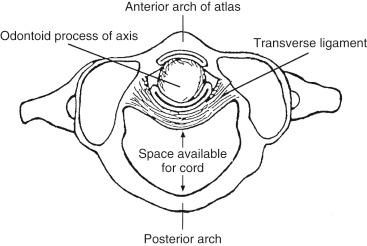Physical Address
304 North Cardinal St.
Dorchester Center, MA 02124
A 79-year-old man presents with C1 and odontoid fractures sustained in a fall down stairs while he was intoxicated. He was found at the bottom of the stairs 2 days after the injury. In addition to alcoholism, the patient has a history of hypertension and smokes one to two packs of cigarettes per day. The patient is not oriented to time, place, or person and has inappropriate verbal responses, but there is no apparent neurologic deficit.
Cervical spine stability is defined as the ability of the spine to maintain relationships between vertebrae during physiologic loading, so as not to damage contained neural structures. Cervical spine instability occurs when physiologic loading causes patterns of vertebral displacement that jeopardize the cervical spinal cord. The muscles of the neck, along with ligamentous structures, intervertebral disks, and osseous articulations, all play a role in cervical spine stability. Upper cervical spine stability may be affected by trauma, congenital disorders, and inflammatory diseases, all of which may result in atlantoaxial instability ( Box 27.1 ).
The cervical spinal cord is particularly prone to injury because of spinal flexibility and the mass of the head. The spinal cord is injured when the ligaments, muscles, and osseous structures fail to dissipate the energy of impact. Transmission of this energy results in microhemorrhage in the spinal cord central gray matter and loss of neurotransmission in the surrounding white matter. A biochemical cascade that destabilizes the neurologic axon membrane and promotes vasospasm creates a secondary injury pattern after the initial insult. Also, primary cervical spinal cord injury leads to altered autonomic tone, loss of autoregulation, depressed cardiovascular function, and hypotension.
A traumatic atlantoaxial dislocation (atlantodental interval of >3 mm in adults older than 18 and >5 mm in children) occurs with forced displacement of the neck such as those sustained during tackling in football or rugby and often is associated with head injuries. If atlantoaxial dislocation or a type II odontoid fracture (fracture occurs at the base of the odontoid between the transverse ligament and the body of C2) occurs, there is a very high likelihood of ligamentous injury. The transverse ligament normally allows no more than 3 mm of anteroposterior translation between the odontoid and the anterior arch of the atlas. If disruption of this ligament occurs, displacement of the odontoid reduces the space available for the spinal cord ( Fig. 27.1 ). In the normal spine, the space available for the spinal cord is about 20 mm. Cord compression does not occur when the space is greater than 18 mm, but it does occur if it is less than 14 mm.

Become a Clinical Tree membership for Full access and enjoy Unlimited articles
If you are a member. Log in here